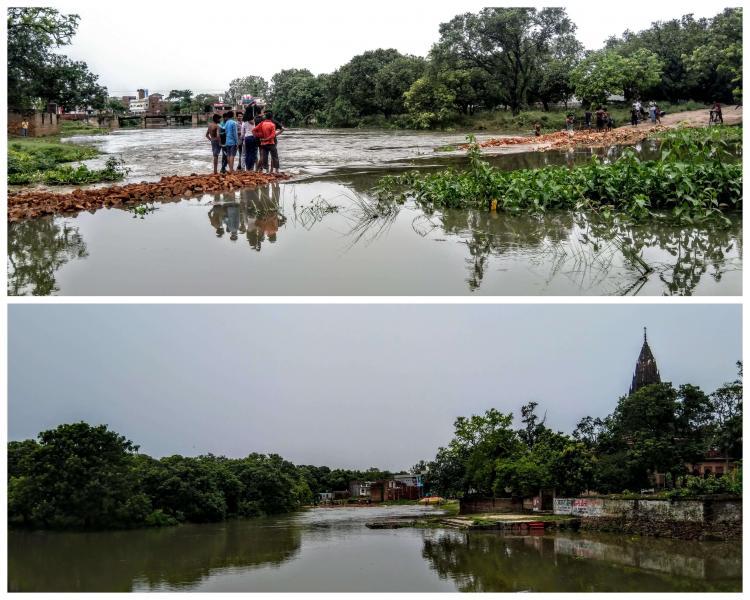Yearly Floods in Bihar: Traditional Dairy Farmers Suffer

Heavy rains have infiltrated the stock of high-priced fodder, aggravating Pradeep’s woes.
“Dub jayi ee sab, kahan jayem hamani ke? (Our homes will be submerged, where will we go?),” laments Asha Devi, “Cattle is hungry, there is shortage of forage.”
Asha Devi comes from Yadav community that has been ravaged by the week-long incessant rain in Sant Ghant area bordering Bairia tehsil of West Champaran district.

Asha Devi has a hut with metal roofing, five cattle and her husbandâs trifling income to her rescue.
Monsoon has put a halt to socio-economic activities in the Northern districts of Bihar; Valmikinagar barrage has released 1.70 lakh cusec water between July 12 and 13 to normalise the pressure exerted on the barrage gates by Gandak which originates from Himal region of Nepal and flows across West Champaran, Gopalgunj, Saran and Muzaffarpur districts before joining Ganges in Sonpur. This has elevated the water level of the stream in Gandak and its tributaries across the regions spanning its flow length.
Yadavs living in the Sant Ghat suburb migrated from Azamgarh district of Uttar Pradesh some four generations ago in search of better opportunities in Bettiah Raj. In the 19th century, Maharaja of Bettiah Raj laid down Chandrawat river, a Gandak tributary descending from Ratwal village of Bagaha tehsil to Sonar Gaon of West Bengal for enhancing the transportation routes; the stones were imported through the waterway. After the death of Maharaja Harendra Kishore Singh, British neglected the Chandrawat as Railways evolved as an efficient mode of transportation.
Sant Ghat – abutting Chandrawat – once hosted the Snanagar (bathroom) of Maharani Janki Kunwar. It further developed into a suburb compassing the population from nearby Bhojpuri belt as Bettiah Raj fell in the hands of British. Yadavs are the oldest community who have been living in this stretch of land since it was opened for public housing. Now, they are the most affected.

Overflowing river-water washed away the diversion route; local herders are primarily affected by the bureaucratic negligence.
Asha, in her late thirties, is the mother of four children – two sons and two daughters. Sandeep, 18, helps Asha in livestock management; Raju is pursuing school education in Motihari. Priya Kumari, the youngest daughter of Asha is enrolled in grade VII in Shanti Kanya School in the town, but is failing to attend classes as rains have flooded most of localities in the town pushing daily life to a pause. Priya says, “If I take the risk of going in the rain, I will return with fever. Who will then help maa in her daily chores? Bhaiya has gone to distribute milk in the town.”
Priya’s father Ramji Yadav works in a local gas delivery agency located on the other side of Chandrawat river. Asha questions, “Do you think this livestock will support basic needs in this age of inflation? His [Ramji’s] income is the main bread winner for us,” she adds.
The collapse of Sant Ghat bridge over Chandrawat is immensely contributing to the suffering of Yadavs since last year. Diversion made over the river to channelise the traffic load from Khiriya Ghat bridge has now been washed away by rains. This has generated a sense of fear among Yadavs, the local hut dwellers. Bank erosion is taking an ugly shape in this area. Yadavs who have a legal right over this stretch of land fear the loss the river may cause. “There is market on the other side. On this side, there is nothing except for a few general stores. I have this hut [points to her house]. If it rains for even a few more days, it will fall.” Rainwater is dripping from the roof of Asha’s hut with perforated metal roofing; hut is yet to be repaired. Asha has not received a single penny under the government’s housing scheme meant for BPL (Below Poverty Line) families. Locals allege that Anish Akhtar, local ward member, gets their signs on the random documents in order to pass some funds, but they receive nothing except for the PDS ration. Most of community members are suffering at the hand of illiteracy as they are unable to decipher the content of the documents they are asked to sign.
Jagdish Yadav, in his late sixties, is the eldest community member. While Jagdish’s family has shifted to a nearby locality away from the river bank, Ramji has no money to afford any rent; thus, left to face the manifestation of river. However, Jagdish’s fears are still strong as livestock, his only source of income, is here in the cow shed, tied onto pegs. Jagdish has just come back after having lunch, his cattle wait for the fodder. Jagdish, affirming the yearly cycle of suffering, says, “Nadi me sab dahata…lehana ghash ketare ayi…ab jathi ba, khiyawal jata..sal dar sal ke ihe kahani ba. (Everything is submerging in the river. How will we get fresh grass for the cattle? Whatever we have, we are feeding them. This is an annual issue for us.)”
Like Jagdish, all Yadavs used to take cattle to the other side of the river for grazing. As the bridge has collapsed and river flow has overpowered the diversion, the only hope for cattle’s survival is haymow and dried rice straw.
Pradeep Yadav, Jagdish’s younger brother, is facing the worst crisis of his life as gush of Chandrawat’s water is eroding his part of land. There is no embankment erected on Chandrawat to counteract the fusillade of streams into residential areas situated on its bank across the suburb. “Water has flown into our homes; rainwater has increased the level of river flow. I have to keep an eye on the buffaloes. If they mistakenly enter the river, they will be carried away,” says Pradeed. He adds, “Khaie san, tabe nu duhaiye san. Gabhin bade san, auri khiawal jala ta inha ta chara pani me sadata. (The milk yield will increase only if the cattle are routinely fed. They are pregnant, they need more to eat. In contrast, the dry fodder is rotting as rainwater is transuding in the stock.)”
Pradeep took a loan of Rs. 24,000 to get four trailer-truck(s) of hay. Pradeep feels that it will be difficult for him to repay the loan on time. Pradeep tells us that cattle don’t eat dry hay, to trick them, wheat bran is mixed in the frugal meal. Chokar, the wheat bran, costs Rs. 20 per kg while khari is sold at Rs 40 per kg. Each buffalo is fed four buckets of hay thrice a day, Pradeep says, while a cow eats only two buckets of hay thrice a day. Pradeep owns eight buffaloes and two cows.
Pradeep has spent all his life here but he feels that the business of dairy farming is not any more profitable. He says,” We feed fodder of minimum of Rs. 600 per day but maximum we earn after ferrying milk across the town is just Rs. 1000. Is that enough to feed a family of six?” “Every year our life becomes hell in the rainy season. I am old. I neither have energy nor money. How will I be able to manage so many cattle?”
When asked about dominance of Yadavs in Bihar politics, Pradeep says, “Ke kahela ki yadavji log ke raj ba. Ihe raj ba…kichad paki. Neta ke koi jaat na hola…neta girgit hola. Dekh leni sab ke hamni ke. (Who says that Yadavs rule Bihar? Yes, we are ruling…in this mud. Politicians have no caste, they are chameleons. We have seen all of them.)
Nitesh Yadav, Pradeep’s eldest son is a helping hand in Pradeep’s dairy farming. He loads the milk pails on his bicycle each day to ferry them to the market and some households. Nitesh says, “Buffalo milk is Rs 40 per litre, cow milk they buy at Rs. 45. How much profit can we make for these nominal rates?” Pradeep’s youngest son Nirbhay goes to an elementary school. He doesn’t want to continue with the traditional dairy farming.
Rita Devi, Pradeep’s relative, tells us that reconstructing diversion route would be a great relief for the dairy farmers. “It was only damaged because thekedar (contractor) didn’t put enough hume pipes in the structure,” Rita says.
As Pradeep plans to cover the mud with dry soil, which costs Rs 400 per trailer-truck, Pradeep’s relatives Chhotelal Yadav and Gopal Yadav among many others feel forced to sell the livestock and discard the traditional dairy farming. Most of them have fled their homes to avoid drowning, few are still here to face the nature’s wrath.
Administration’s stratagem for flood has catastrophically failed in this flood-prone region. DM Dr Nilesh Chandra Devre has reportedly suspended the remaining payment of the contractor on the charges of corruption in the diversion construction project.
Narayan Prasad, MLA from Nautan Assembly constituency, has promised the electorate speedy construction of Sant Ghat bridge which has been the only transportation route for the two-thirds of the people of Nautan, Bairia and adjacent rural areas commuting to the district capital. However, NewsClick has found that tender for the Sant Ghat bridge is yet to be sanctioned even after first anniversary of its of its collapse.
Get the latest reports & analysis with people's perspective on Protests, movements & deep analytical videos, discussions of the current affairs in your Telegram app. Subscribe to NewsClick's Telegram channel & get Real-Time updates on stories, as they get published on our website.
























